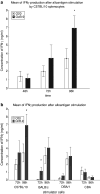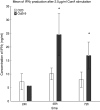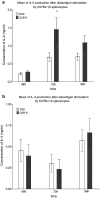Loci controlling lymphocyte production of interferon c after alloantigen stimulation in vitro and their co-localization with genes controlling lymphocyte infiltration of tumors and tumor susceptibility
- PMID: 19655140
- PMCID: PMC2776939
- DOI: 10.1007/s00262-009-0739-y
Loci controlling lymphocyte production of interferon c after alloantigen stimulation in vitro and their co-localization with genes controlling lymphocyte infiltration of tumors and tumor susceptibility
Abstract
Low infiltration of lymphocytes into cancers is associated with poor prognosis, but the reasons why some patients exhibit a low and others a high infiltration of tumors are unknown. Previously we mapped four loci (Lynf1–Lynf4) controlling lymphocyte infiltration of mouse lung tumors. These loci do not encode any of the molecules that are involved in traffic of lymphocytes. Here we report a genetic relationship between these loci and the control of production of IFNγ in allogeneic mixed lymphocyte cultures (MLC). We found that IFNγ production by lymphocytes of O20/A mice is lower than by lymphocytes of OcB-9/Dem mice (both H2pz) stimulated in MLC by irradiated splenocytes of C57BL/10SnPh (H2b) or BALB/ cHeA (H2d) mice, or by ConA. IFNγ production in MLCs of individual (O20 9 OcB-9)F2mice stimulated by irradiated C57BL/10 splenocytes and genotyped for microsatellite markers revealed four IFNγ-controlling loci (Cypr4-Cypr7), each of which is closely linked with one of the four Lynf loci and with a cluster of susceptibility genes for different tumors. This suggests that inherited differences in certain lymphocyte responses may modify their propensity to infiltrate tumors and their capacity to affect tumor growth.
Figures




Similar articles
-
A new type of genetic regulation of allogeneic response. A novel locus on mouse chromosome 4, Alan2 controls MLC reactivity to three different alloantigens: C57BL/10, BALB/c and CBA.Genes Immun. 2000 Dec;1(8):483-7. doi: 10.1038/sj.gene.6363711. Genes Immun. 2000. PMID: 11197689
-
Control of lymphocyte infiltration of lung tumors in mice by host's genes: mapping of four Lynf (lymphocyte infiltration) loci.Cancer Immunol Immunother. 2008 Feb;57(2):217-25. doi: 10.1007/s00262-007-0367-3. Epub 2007 Aug 17. Cancer Immunol Immunother. 2008. PMID: 17703301 Free PMC article.
-
Identical genetic control of MLC reactivity to different MHC incompatibilities, independent of production of and response to IL-2.Immunogenetics. 1996;44(1):27-35. doi: 10.1007/BF02602654. Immunogenetics. 1996. PMID: 8613140
-
Interferon-gamma plays a crucial role in T lymphocyte reaction against alloantigens.Ric Clin Lab. 1985 Oct-Dec;15(4):307-14. doi: 10.1007/BF03029144. Ric Clin Lab. 1985. PMID: 2939532
-
A novel alloreactivity-controlling locus, Alan1, mapped to mouse chromosome 17.Immunogenetics. 2000 Jul;51(8-9):755-7. doi: 10.1007/s002510000197. Immunogenetics. 2000. PMID: 10941849 No abstract available.
Cited by
-
Mice with different susceptibility to tick-borne encephalitis virus infection show selective neutralizing antibody response and inflammatory reaction in the central nervous system.J Neuroinflammation. 2013 Jun 27;10:77. doi: 10.1186/1742-2094-10-77. J Neuroinflammation. 2013. PMID: 23805778 Free PMC article.
-
Genetic Influence on Frequencies of Myeloid-Derived Cell Subpopulations in Mouse.Front Immunol. 2022 Jan 26;12:760881. doi: 10.3389/fimmu.2021.760881. eCollection 2021. Front Immunol. 2022. PMID: 35154069 Free PMC article.
-
Mapping the genes for susceptibility and response to Leishmania tropica in mouse.PLoS Negl Trop Dis. 2013 Jul 11;7(7):e2282. doi: 10.1371/journal.pntd.0002282. Print 2013. PLoS Negl Trop Dis. 2013. PMID: 23875032 Free PMC article.
-
Gene-specific sex effects on eosinophil infiltration in leishmaniasis.Biol Sex Differ. 2016 Nov 22;7:59. doi: 10.1186/s13293-016-0117-3. eCollection 2016. Biol Sex Differ. 2016. PMID: 27895891 Free PMC article.
-
A novel locus on mouse chromosome 7 that influences survival after infection with tick-borne encephalitis virus.BMC Neurosci. 2018 Jul 6;19(1):39. doi: 10.1186/s12868-018-0438-8. BMC Neurosci. 2018. PMID: 29976152 Free PMC article.
References
-
- Galon J, Costes A, Sanchez-Cabo F, Kirilovsky A, Mlecnik B, Lagorce-Pages C, Tosolini M, Camus M, Berger A, Wind P, Zinzindohoue F, Bruneval P, Cugnenc PH, Trajanoski Z, Fridman WH, Pages F. Type, density, and location of immune cells within human colorectal tumors predict clinical outcome. Science. 2006;313:1960–1964. doi: 10.1126/science.1129139. - DOI - PubMed
Publication types
MeSH terms
Substances
Grants and funding
LinkOut - more resources
Full Text Sources
Molecular Biology Databases

